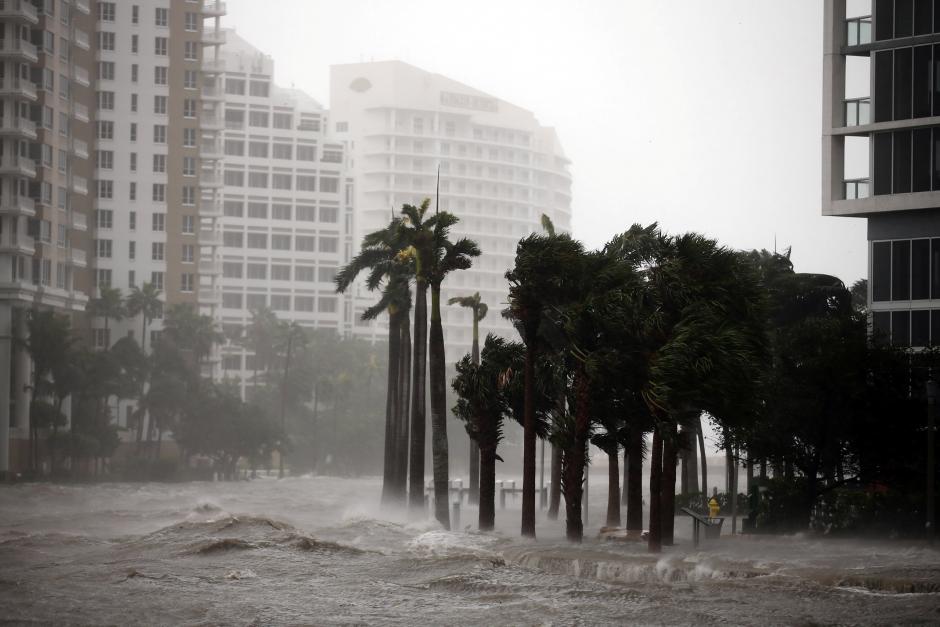Weakened to a Category 1 hurricane prior to hitting landfall on the coast of the US state of Florida, Irma still left destruction in its wake as storm surges and strong winds left millions without power, flooded streets and tore roofs off homes.
With communication cut to some of the Florida Keys, where Irma made landfall Sunday, and rough conditions persisting across the peninsula, many held their breath for what daylight might reveal.
Irma came ashore on Florida on Sunday and battered towns up and down the state.
Once one of the most powerful storms recorded, it weakened to a Category 1 hurricane, carrying maximum sustained winds of about 85 miles per hour (135 km per hour) by 2 a.m. ET (0600 GMT) on Monday. The storm was churning northwest in the center of the state near the Tampa and Orlando metro areas on Monday morning, the National Hurricane Center said.
The storm killed at least 28 people as it raged westward through the Caribbean en route to Florida, devastating several small islands, and grazing Puerto Rico, the Dominican Republic and Haiti before pummeling parts of Cuba’s north coast with 36-foot-tall (11-m) waves.
Irma was ranked a Category 5, the rare top end of the scale of hurricane intensity, for days and its ferocity as it bore down on hurricane-prone Florida prompted one of the largest evacuations in US history. Some 6.5 million people, about a third of the state’s population, had been ordered to evacuate southern Florida. Residents fled to shelters, hotels or relatives in safer areas.
On Sunday, Irma claimed its first US fatality – a man found dead in a pickup truck that had crashed into a tree in high winds in the town of Marathon, in the Florida Keys.
High winds snapped power lines and left about 4.5 million Florida homes and businesses without power in the state, whose economy represents about 5 percent of US gross domestic product. Utility officials said it will take weeks to restore electricity to everyone.
Upon leaving Florida, a weakened Irma is expected to push into Georgia, Alabama, Mississippi, Tennessee and beyond. A tropical storm warning was issued for the first time ever in Atlanta.
It could dump as much as 25 inches (63.5 cm) of rain in parts of Florida and as much as 16 inches in parts of Georgia, prompting flash flood and mudslide warnings, the National Hurricane Center said.
Local TV news video of damage in Naples, a city on the Gulf coast about 125 miles (200 km) to the northwest of Miami, showed buildings ripped apart by hurricane winds and streets flooded by rain and storm surges.
Storm surge and tornadoes were two big concerns. The National Hurricane Center said a federal tide gauge in Naples reported a 7-foot (more than 2-meter) rise in water levels in just 90 minutes late Sunday. And an apparent tornado spun off by Irma destroyed six mobile homes in Palm Bay, midway up the Atlantic coast. Flooding was reported along Interstate 4, which cuts across Florida’s midsection.
The storm’s westward tilt to Florida’s Gulf Coast spared the densely populated Miami area the brunt of its wrath, although the wide reach of the hurricane meant the state’s biggest city was still battered.
Miami apartment towers swayed in the high winds, three construction cranes were toppled, and small white-capped waves could be seen in flooded streets between Miami office towers.
Waves poured over a Miami seawall on Sunday, flooding streets waist-deep in places around Brickell Avenue, which runs a couple of blocks from the waterfront through the financial district and past foreign consulates. High-rise apartment buildings were left standing like islands in the flood.
Police in Miami-Dade County said they had made 29 arrests for looting and burglary. “We’re on patrol and won’t tolerate criminal activity as our community recovers from Hurricane Irma,” it said on its twitter.
The storm and evacuation orders caused major disruption to transportation in the state that is a major tourist hub. Thousands of flights were canceled.
Miami International Airport, one of the busiest in the country, halted passenger flights through at least Monday and will see if it can resume those operations on Tuesday.
Irma, which was expected to cause billions of dollars in damage to the third-most-populous US state, it hit just days after the Houston area was deluged by unprecedented flooding from Hurricane Harvey, which dumped more than 50 inches (127 cm) of rain in parts of Texas.
Harvey killed at least 60 people and caused an estimated $180 billion in property damage.
US President Donald Trump, acting at the governor’s request, approved a major disaster declaration for Florida on Sunday, freeing up emergency federal aid in response to Irma, which he called “some big monster.”
